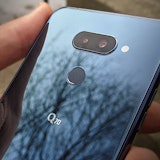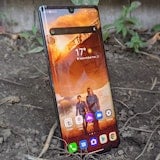
The LG G Flex is the first curved-display smartphone from LG. It’s a phablet-sized device with some small amount of durability thanks to the semi-bendy screen and a ‘self-healing’ plastic used for the rear plate.
It was never really meant to be a flagship or big seller. In fact, it’s a borderline proof-of-concept device for LG’s continued research in to truly flexible display tech. Despite this, it’s a solid phone and one of the better big-kahunas we’ve reviewed in a while.
Design

The G Flex is immediately striking thanks to the curved design. It makes what would otherwise be a standard-looking phone look downright high-tech, although you may end up finding yourself answering "why?" a lot once your friends and family get a look at it.
The bezels are impressively thin at the sides and there’s little room wasted at the top and bottom. There’s no capacitive keys here, LG has made good use of Android’s on-screen button to provide a large-screened device with minimal bulk.
In the past we’ve experienced discomfort with most 6-inch phablets, but the G Flex is surprisingly comfortable in the pocket thanks to the curve. It fits in close to the thigh much more snugly than does a regular flat device. You can even keep it in your back pocket without creating too much of an unsightly bulge and, best of all, you don’t even have to worry about sitting on it.

The best part of the G Flex is in the name: it’s flexible. That is to say, it has a bit of give when you apply pressure to it. The screen panel, screen overlay and battery are all designed to take a fair amount of pressure and bending without damage. You can’t drop it on concrete or anything like that, but a steady applied force like sitting, stepping or pushing on it did nothing in our tests. You can even place it on a desk and force it flat with no harm.
The rear plate’s ‘self-healing’ plastic was a bit of a let-down at first. We’d seen LG’s impressive scratch-tests and taken them at face value. In reality the self-healing process is minimal, but it’s better than nothing. The small nicks and scratches that usually plague glossy phones are significantly reduced after a few minutes. That being said, anything more substantial and you’ll soon learn its limitations.
In what is now standard LG-style the lock and volume buttons are located on the back. This is more useful here than it was on the LG G2. Large phones can often make it difficult to reach buttons with ease, and the back orientation was easy to reach. We think it could be improved further by lowering them for folks with smaller hands. Alternatively LG could just thrown them on the side like everybody else.
If you’re worried about locking and unlocking the phone while it’s on a desk then never fear. LG has instituted a great tap-on and tap-off command for the screen. Just make sure you’re tapping on an empty area of the Home screen if you’re trying to go in to standby or you’ll start opening apps unexpectedly.
Display

The curved display is a mixed bag. For one, its OLED panel provides almost perfect viewing angles. Granted, one tends to not view a smartphone from an angle, but it’s an eye-catching constant reminder that there’s something special about this phone.
It's also very bright and, thanks to the curve, is usable in direct sunlight. This blessing is also a curse. While the curve usually reflects sunlight away from you, get it on just the wrong angle on a sunny day and you'll be temporarily blinded.
The curve itself doesn’t add much to the actual UI experience. Watching movies in full-screen is kind of cool, but it’s certainly not enough of a reason to pick the G Flex over any other handset.

Where the screen falls short is in resolution and color accuracy. It’s only a 720p panel, which normally wouldn’t be too bad except that it’s stretched out over such a large area. Anyone used to 1080p displays will notice the lack of crispness. However, most people who are buying a new phone aren’t coming from 1080p yet, so it shouldn’t be an issue for them.
As for color the whole thing had a very bluish hue that was noticeable even without holding it next to another device. This is a limitation of the current OLED flexible panels that we hope will be ironed out in future.
UI and speed

The UI is standard fare. It’s got most of what you’d expect to find on an Android device: Home screens, quick settings, widgets etc. It also has a couple of cool features.
One lovely little touch happens during setup. When you first turn on the G Flex, it’ll ask you to configure the on-screen keys. You can choose to have the Menu on the left and Back on the right or vice-versa. Home is always in the middle. We’d like to see this kind of thing more often. We’re also big fans of the Menu button making a showing instead of a dedicated Task Manager button.
Our favorite of addition is Slide-Aside. Swiping to the right with 3 fingers will bring up the Slide-Aside view, which lets you switch between your 3 most recent apps very easily. Normally you could just do this with a Task Manager key, but LG cleverly chose to switch that out for Menu and gave us Slide-Aside instead.

As for speed and smoothness the G Flex handled everything incredibly well. Its powerful 2.26MHz quad-core Snapdragon 800 CPU paired with 2GB of RAM is more than up to the task of anything on the market right now.
There’s also 32GB of on-board storage, 24GB of which is available to the user. Unfortunately there is no MicroSD slot for expanding that any further.
Battery

Battery life on the G Flex is outstanding. The huge 3500mAh battery consistently gave us a 2-day charge. Sure, you can use the whole thing up in one day if you’re a power-user, but for day-to-day operations you really only need to charge it every second night.
We’re unashamedly huge fans of any device that frees us even slightly from our wall chargers. It may seem like no big deal, but wait until you’ve tried it. Charging your phone only half as often is a wonderful and liberating experience.
Camera

The 13MP camera on the G Flex is pretty good. It takes clear photos in the daytime, although it does have a bit of difficulty with glare or contrasting lighting. You usually have to choose between a good shot with a whited-out sky, or a blue sky with a darker shot.

In low light it suffers a bit. It’s about as good as the last-generation top-ends like the Galaxy S4, although not quite. It also has some difficulty with movement.
In short, this isn’t a camera for the camera-centric user, but it will suffice for photos of friends, family, food and foliage.

Video capture is also good but not great. Like with other modern phones, the option to capture in 4K is there, but most screens don’t support 4K yet and viewing a 4K video in 1080p (or on the 720p G Flex screen) is an exercise in futility.
Verdict

The LG G Flex surprised us. We have to admit we came in expecting a gimmick phone, but what we found was a reliable and usable device. The curved screen actually did improve on the experience, even if it was only for comfort and a bit of durability when keeping it in the pocket.
The UI was smooth and the display was bright and responsive, although it wasn’t the most crisp or the best when it comes to color purity. Battery life was fantastic at 2 days, the camera was more than passable and the overall build was sensible and comfortable.
There’s usually at least one glaring flaw with larger devices that leaves us feeling like the manufacturer didn’t take things too seriously. None of that was evident here. The LG G Flex does everything right, but nothing amazingly. Still, when it comes to phablets that’s high praise.
Related Articles
Find Better Phones and Plans
Hundreds of cell phone plans unpacked. All the facts. No surprises.



































